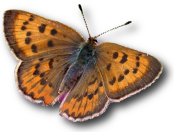A new study covering 159 species of butterfly that were monitored for over 35 years has just been published in the Proceedings of the National Academy of Sciences. This is the first major paper resulting from the remarkable research program of Professor Art Shapiro at UC Davis. Art's project consists of 11 sites which he visits every two weeks, and extend from Suisun Marsh in the Bay Area, across the central valley, and up and over the Sierra Nevada to a final point at Sierra Valley on the east side.
Their most significant findings:
- Butterfly diversity (the number of different species present) is falling fast at all the sites near sea level, in the central valley, and the foothills. It is also declining, but more slowly, in the mountains.
- The highest monitoring sites, at tree line, show an increase in butterfly diversity, as lower-elevation species react to the warming climate by moving upslope to higher, cooler elevations.
- However, among butterflies adapted to the highest elevations, the number of species is beginning to fall because temperatures are becoming uncomfortably warm for them.
“There is nowhere to go except heaven,” Shapiro said.
Another surprising finding was that ruderal (“weedy”) butterfly species that breed on “weedy” plants in disturbed habitats and are highly mobile are actually declining faster than “non-weedy” species — those that specialize in one habitat type.


